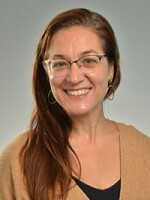Alejandro Sánchez Alvarado just got back from vacationing with a colleague at the Great Barrier Reef in Australia. The two were taking a leisurely walk along the water's edge when they decided to turn over a rock, just to see what might be underneath it.
"We lift it up and we find at least four or five different species of tunicates. These are like a squirt fish," Sánchez Alvarado recalls. Two of them, his colleague — an Australia native — had not seen before.
Sánchez Alvarado also noticed what was "very likely an undescribed species of bryozoan." It took the duo only an hour to determine that the species were unkown to science.
"This is not that we are lucky," he insists. "There is an abundance of the unknown out there and not many of us are taking the time to seek it out and try to understand."
And, he says, "there are many things that are invisible to us by choice."
Sánchez Alvarado's claim to fame in the scientific community is unlocking the key to regenerating dead cells within a living organism. He explains that while we tend to think of life and death as binary, living organisms spend most of their existence on a continuum, with the number of dying cells gradually taking over the number of living cells until we die.
"When we see people age, what's happening is, the number of cells that are dying is outpacing the number of cells replacing them. So you know, we get wrinkles, our muscle begins to get less firm."
Sánchez Alvarado and his staff at the Stowers Institute for Medical Research have figured out how to inject a single cell containing instructions into organisms still alive but "fated to die" and bring dead cells back to life, thereby bringing the entire organism back "from the brink."
It's the stuff of science fiction plots, and his eureka moment was fittingly cinematic. He was alone in his lab at 3 in the morning, looking at flatworms under the microscope when he saw their cells regenerating.
"I couldn't believe it," he says.
What he'd seen was so astonishing, in fact, that he called a colleague at home, woke him up and asked him to come into the lab to confirm what he'd just seen.
The implications for other life forms are still unclear. Sánchez Alvarado's lab is currently investigating whether the success they've had regenerating cells in flatworms could be translated to larger, more complex organisms like freshwater fish and snails. All organisms regenerate cells to some degree or another. Flatworms happen to be good at it, whereas humans, for example, are only so-so; we can't regenerate amputated limbs, but we resurface our intestinal linings all the time.

Sánchez Alvarado's passion for science goes back to his childhood in Venezuela. Born and raised in the metropolis of Caracas, he spent summers with family on a cattle ranch near the jungle, where "life was brimming from every corner."
He was spellbound by nature. He watched pirhanas devouring animal carcases; it happened so fast. He watched butterflies emerge from pupas, marveling at the thin layers wrapped around this humble caterpillar, which would later turn into a beautiful creature's wings.
Sánchez Alvarado's life journey, from there, has really been a journey from studying the wonders of the universe out in nature to doing it in the lab. It mirrors the trajectory of science itself, beginning with famous scientists making discoveries, like Newton under apple trees, before putting on lab coats.
Except that recently, Sánchez Alvarado has been venturing back out into nature.
"It used to be that we scientists had to control the environment so much that we invented laboratories," he says, meaning scientists had to bring life out of nature and into the lab to study it.
"Technology has moved forward so rapidly that now it is really conceivable to bring the lab back to nature, such that we can look at life in its proper environment, where it actually was chiseled, where it actually interacts with other things."
Such as when a scientist heads out for a walk on a beach. Because you never know what's out there if you're not looking.
Portrait sessions are intimate conversations with some of the most interesting people in Kansas City paired with photographs by Paul Andrews. You can listen to Gina Kaufmann's entire conversation with Alejandro Sanchez Alvarado here.
Gina Kaufmann is the host of KCUR's Central Standard. You can reach her on Twitter, @GinaKCUR.





